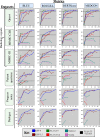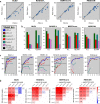This is a preprint.
Clinical Text Summarization: Adapting Large Language Models Can Outperform Human Experts
- PMID: 37961377
- PMCID: PMC10635391
- DOI: 10.21203/rs.3.rs-3483777/v1
Clinical Text Summarization: Adapting Large Language Models Can Outperform Human Experts
Update in
-
Adapted large language models can outperform medical experts in clinical text summarization.Nat Med. 2024 Apr;30(4):1134-1142. doi: 10.1038/s41591-024-02855-5. Epub 2024 Feb 27. Nat Med. 2024. PMID: 38413730 Free PMC article.
Abstract
Sifting through vast textual data and summarizing key information from electronic health records (EHR) imposes a substantial burden on how clinicians allocate their time. Although large language models (LLMs) have shown immense promise in natural language processing (NLP) tasks, their efficacy on a diverse range of clinical summarization tasks has not yet been rigorously demonstrated. In this work, we apply domain adaptation methods to eight LLMs, spanning six datasets and four distinct clinical summarization tasks: radiology reports, patient questions, progress notes, and doctor-patient dialogue. Our thorough quantitative assessment reveals trade-offs between models and adaptation methods in addition to instances where recent advances in LLMs may not improve results. Further, in a clinical reader study with ten physicians, we show that summaries from our best-adapted LLMs are preferable to human summaries in terms of completeness and correctness. Our ensuing qualitative analysis highlights challenges faced by both LLMs and human experts. Lastly, we correlate traditional quantitative NLP metrics with reader study scores to enhance our understanding of how these metrics align with physician preferences. Our research marks the first evidence of LLMs outperforming human experts in clinical text summarization across multiple tasks. This implies that integrating LLMs into clinical workflows could alleviate documentation burden, empowering clinicians to focus more on personalized patient care and the inherently human aspects of medicine.
Figures













References
-
- Abacha A. B., Yim W. w., Adams G., Snider N. & Yetisgen-Yildiz M. Overview of the MEDIQA-Chat 2023 Shared Tasks on the Summarization & Generation of Doctor-Patient Conversations in Proceedings of the 5th Clinical Natural Language Processing Workshop (2023), 503–513.
-
- Agarwal N., Moehring A., Rajpurkar P. & Salz T. Combining human expertise with artificial intelligence: experimental evidence from Radiology tech. rep. (National Bureau of Economic Research, 2023).
-
- Ben Abacha A. & Demner-Fushman D. On the Summarization of Consumer Health Questions in Proceedings of the 57th Annual Meeting of the Association for Computational Linguistics, ACL 2019, Florence, Italy, July 28th - August 2 (2019).
-
- Best Practices for Prompt Engineering with OpenAI API https://help.openai.com/en/articles/6654000-best-practices-fo-rprompt-en.... Accessed: 2023-09-08. OpenAI, 2023.
Publication types
Grants and funding
LinkOut - more resources
Full Text Sources

